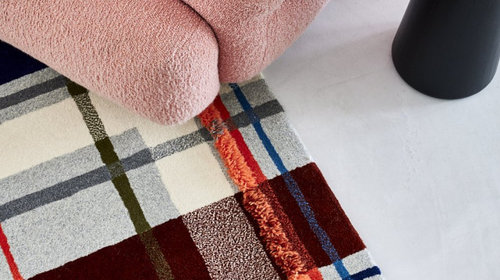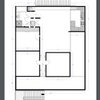How to choose the right rug and carpet?

Choosing the right carpet and rug can brighten a space and bring life to any area of your home. Check out this article for everything you need to know when picking the perfect carpet or rug
HOW TO PICK A RUG
There are lots of things to bear in mind when choosing the perfect rug for a room, from material to colour to placement to weave. It can all seem overwhelming when you first start looking through catalogues and websites! In this rug buying guide we will take you through each decision step by step so you can be sure you’re making the right choice.
WHICH ROOM?
Different rooms need different kinds of rugs. You don’t want to put a thick woollen rug in your hallway as it will hold onto every bit of dirt and mud, making it impossible to clean. High traffic areas such as hallways and kitchens are best suited to rugs that are hardwearing and easy to clean. You might want to consider rugs with dark patterns that can hide stains that you can’t get out. Similarly, you shouldn’t put a hardwearing and coarse rug in your bedroom as it will be uncomfortable under bare feet. Alternatively, you can put super comfortable, soft and high pile rugs in bedrooms and living rooms with lower footfall and in places where you won’t have to worry so much about keeping them clean.
SIZE AND SHAPE
There’s a saying in the rug industry: bigger is usually better. If you put a small rug on its own in a large space it will give the appearance that it’s ‘floating’ in the middle of some place it shouldn’t be. You either want your rug to go underneath and around all the furniture in your room or, if that’s not possible, to go under the front feet or all the furniture in the room. Depending on the space you might need a square or rectangular rug to do that. Before you look at anything, when you’re at home take a tape-measure and measure out the size you want your rug to be so you know what you’re looking for before you leave!
MATERIAL
Now that you know which room your rug is going to go in and the size and shape you want it to be, you need to move on to what can seem like the most daunting part of the decision – the material. But don’t worry, choosing the best material doesn’t need to be overwhelming.
ACRYLIC
Acrylic is both cheap and easy to maintain. It doesn’t shed any of its fibre, so it lasts a long time and you don’t have to worry about losing half your rug every time you vacuum! It varies in quality from soft to coarse depending on how well it has been made, so if you’re buying acrylic look for a rug with a high knot count. Acrylic is hard-wearing, which makes it perfect for entrance ways and hallways. Also, it dyes easily so you can get lots of interesting patterns and colours. Consider a statement rug in the entranceway of your home that really shows off your personality.
NATURAL WOOL
When you think about digging your toes into a nice thick rug, you’re probably thinking about a wool rug. Wool is super soft, warm, easy to clean and heat resistant – making it perfect to have in front of a fire or beside your bed. It’s also completely sustainable and biodegradable, because it’s naturally farmed. However, all these things make it more expensive than other options, especially for felted wool.
SILK
There’s a reason silk is associated with emperors, queens and Hollywood stars on the red carpet… It’s because silk is probably the highest quality fabric in the world. All the hard work and creativity of humanity still hasn’t been able to surpass this elegant, beautiful and natural material. The feel is soft and luxurious, and because it’s completely natural it’s much better for the environment than other materials. All these upsides do come with their own problems. It’s delicate, meaning it can be easily torn and if you knock over a glass of red wine or black coffee, it can be easily stained. In addition, it’s the most expensive material on this list. All this means this is not the rug to put in your entranceway. Consider a silk rug for your bedroom, or if you don’t have kids or pets, perhaps your living-room.
SILK ‘LOOKALIKES’ – KRISTAL AND TENCEL
Kristal and Tencel are man-made fabrics designed to look and feel like silk, but are cheaper and easier to mass produce. Both feel great and are more durable and stain resistant than silk, as well as being easier to clean and care for. Tencel is generally the better quality and more expensive of the two options, but both should be only reserved for living-rooms and bedrooms.
PLANT BASED MATERIALS (JUTE, SISAL, SEAGRASS)
There seems to be an increasing number of rugs made out of vegan, plant based materials such as Jute, Sisal and Seagrass. They’ve been used for hundreds of years, and although they went out of fashion in the 20th century they’re coming back as, unlike plastic-based materials such as acrylic and nylon, they are vegan and 100% natural, with small carbon footprints. They are cheap and hard-wearing, but very coarse, so good if you want a natural material for a high footfall area like a hallway or entrance way, but not great for anywhere you might be walking around barefoot. They are generally easy to clean, however, Sisial requires a special dry cleaning kit if it gets wet.
COTTON
There’s a very good chance you are wearing cotton right now – perhaps a soft cotton t-shirt or a nice warm cotton sweater. There’s a reason we use cotton so much – it feels great, it’s natural, cheap and easy to dye any colour you can think of. All this means it’s a great option for a new rug, especially for living rooms and bedrooms where you want to feel it under your feet. The only real downside is that, just like your socks, a cotton rug can wear through faster than other materials so make sure you put it somewhere without too much footfall.
CONSTRUCTION
Rugs come either in ‘High Pile’ or ‘Low Pile’.
High pile is a longer, thicker density option that is deep, comfortable and snug – think about digging your toes into a comfy rug on a cold night. But because it’s thicker, it’s more expensive and it’s easy to get dirt and mess trapped between the fibres. High pile rugs are perfect to put in the living room or bedroom, anywhere that won’t have dirty shoes walking back and forth.
Low Pile is cheaper, with shorter fibres that aren’t as comfortable under your feet but don’t hold onto dirt like high pile rugs. They tend to be thin and hard-wearing compared to high pile rugs. They’re great for high footfall areas and places that need to be regularly cleaned like hallways, entranceways and kitchens.
PATTERN AND COLOUR
What colour and pattern you have on your rug will depend on the material you choose. Some materials, like acrylic, take colours easily so the only limit to what you can have is your imagination.
If you have a room without a lot of colour and energy you might want to consider a rug with bold patterns and bright colours to add energy to a room without being overwhelming. Alternatively, you can help to quieten a bright or busy room with a more plain rug in a simple colour.
TIPS & TRICKS
- Jute and wool are lovely fabrics but can be difficult to clean.
- Consider how much maintenance you will put in. High pile rugs need a lot of work to keep them looking good, whereas low pile and patterned rugs can be easily vacuumed and can often hide dirty marks.
- Choose a rug that has the same tonal pallet as your couch or furniture, but in a different shade. For example, add a sky blue rug to a room with a dark blue couch.
- If you have young kids and animals, a white, woollen, high pile rug probably won’t work. Instead, choose a synthetic rug with a pattern that masks stains.
- If you have a large room, think about using multiple rugs to define different areas of the room.
- Think about the swing of opening doors. These can catch a rug if it’s too close.
- Put a rug pad under your rug to stop it slipping around.
CHOOSING THE RIGHT CARPET
Just like choosing the right rug, you have to think about three important things when choosing the perfect carpet: high pile or low pile; colours and patterns, and material. In this section of the guide we’ll take you through room by room and tell you what to bear in mind when choosing your carpet.
An important thing to think about is, do you have pets and will pets ever go in the room you are carpeting? Some carpets have ‘looped weaves’ which can catch on the claws of cats and small dogs and should therefore be avoided at all costs if you have pets (for their sake and yours).
THE RIGHT CARPET FOR YOUR KITCHEN
It doesn’t matter how clean and tidy a cook you are, sooner or later food will get dropped on your kitchen floor. So you might want to avoid carpet completely around the food preparation area. When buying carpet for any part of your kitchen, choose a carpet with a low pile as these are easier to clean. You might also want to consider a carpet with interesting colours and patterns that can hide any possible stains, and avoid completely pale carpets that easily show marks. Consider Nylon, Acrylic and plant-based materials for your kitchen as these are easy to clean and hard-wearing.
THE RIGHT CARPET FOR YOUR STAIRS
Stairs get a lot of traffic, all day everyday, so you want low pile and hard-wearing materials like Polypropylene, Nylon, Acrylic and plant-based that are easy to clean. The most important thing to bear in mind, is to avoid patterns on your stairs, as these confuse anyone walking up and down and might cause them to fall. Keep the carpet simple and easy to see the edges. If your stairs are made of good looking wood, consider a ‘runner’ down the centre of your stairs that shows off the wood on each side.
THE RIGHT CARPET FOR YOUR LIVING ROOM
There will be a lot less footfall in your living room and fewer people walking through with dirty shoes, so you can choose to have a thick, high pile carpet that will feel good under bare feet – consider cotton, wool, silk or one of the silk lookalikes. Because it will get less dirty than other rooms you can also choose to go for a light coloured carpet if you want. A cream or beige carpet can be a great way of lightening a room that’s got dark furniture or walls.
THE RIGHT CARPET FOR YOUR HALLWAY AND ENTRANCE WAY
The hallway and entrances are probably the most difficult places in your house to choose the right carpet for. It’s the first part of your house guests see, so you want to make a good impression and show off your excellent taste and style, but it’s also the place that gets the most footfall and is most likely to get marked and stained. Because people don’t spend a lot of time in these places, we would recommend practicality and ease of cleaning over picking the most impressive – consider a low pile carpet made from Nylon, Acrylic, or plant-based materials. These materials are easy to clean, hard-wearing and don’t stain too easily.
THE RIGHT CARPET FOR YOUR BEDROOM
When you get out of bed in the morning you want to be able to push your toes into a warm and comfortable carpet that soothes your feet. That means the bedroom is the part of the house where you can choose the deepest, lushest and most comfortable carpet available. And, because the bedroom gets much less footfall than other rooms, you don’t have to worry too much about wearing through the material, so whenever possible, choose a high pile carpet and opt for cotton, wool, silk, Tencel or Kristal. When choosing a pattern or colour, go for something soothing – you probably don’t want the last thing before you go to sleep to be a bright yellow carpet with orange stripes.
TIPS AND TRICKS
- As mentioned above, avoid carpets with looped weaves if you have cats and dogs as their claws can catch in the loops.
- Look into any warranties available, which can last for up to 10 years, and cover ‘bald spots’ caused by wear.
- Some carpets, especially acrylic, come with guarantees against stains.
- Avoid pale and high pile carpets in rooms with kids and animals as they get dirty more easily and are harder to clean.
- If you want your carpet to be the focal point of a room, choose a bright or highly patterned carpet; if you want it to be a backdrop choose a lighter, unpatterned carpet.
- Think about if you want an underlay under your carpet. An underlay acts like a shock absorber and noise absorber, as well as an insulator.
- How much maintenance do you want to put in? High pile carpets need more work to keep them looking good, whereas low pile and patterned carpets can be easily vacuumed and can hide dirty marks.





Related Discussions
I need help with choosing a rug for my lounge area.
Q
Help us choose the right spot for furniture for our family room
Q
Help me choose the right dining chairs
Q
How do you choose a rug under a dining room table?
Q